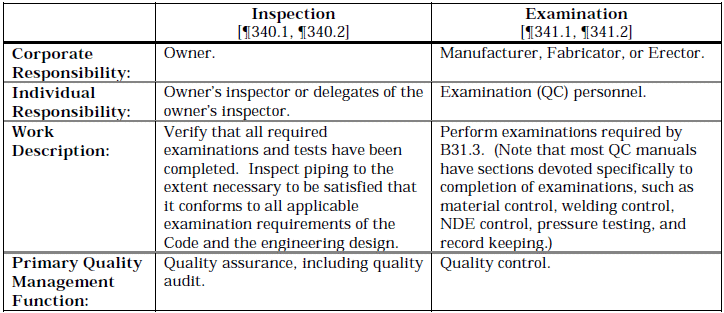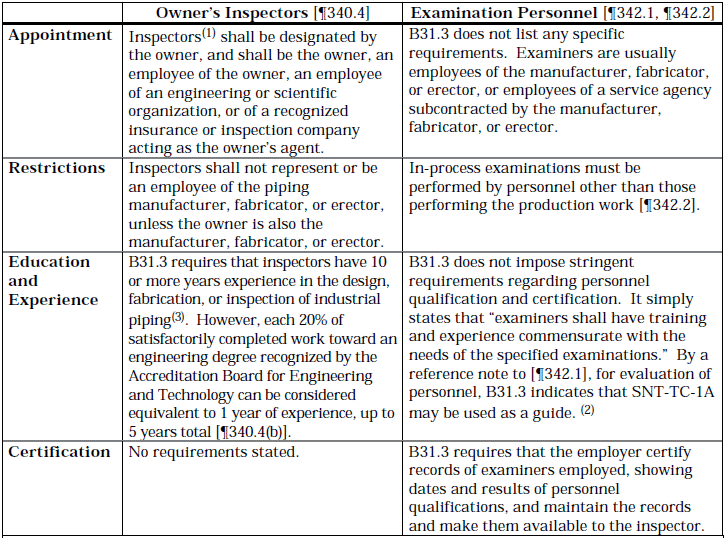 |
Satish Lele lelepiping@gmail.com |
Inspection, examination, and testing are activities carried out to ensure that piping systems meet the minimum requirements of the B31.3 Code and the engineering design. Clauses governing these activities are found mainly in B31.3 Chapter VI (Inspection, Examination, and Testing), with additional requirements in Chapter VIII (Piping for Category M Fluid Service) and Chapter IX (High Pressure Piping).
Inspection Versus Examination: Under B31.3 rules of construction, it should be noted that inspection and examination do not mean the same thing. Table below compares certain defining characteristics for each activity. Although there may appear to be similarities between the actual work of inspectors and examiners on the job, it is important to be able to distinguish the responsibilities associated with each activity. Our ability to make such distinction has improved with the expansion of quality assurance and quality control concepts within the piping industry.


(2) While SNT-TC-1A is certainly a useful document, if such qualifications or equivalent are required, it must be specifically stated in contract documents. Furthermore, the level of qualification (I, II, or III) should be stated in terms of requirements for specific parts of the work. As an example, for radiographic exposure of circumferential butt welds in a process piping system, an ASNT Level I radiographic qualification should be adequate. For interpretation of the resulting radiographs, an ASNT Level II radiographic qualification should be specified. In cases of interpretation dispute, access to an ASNT Level III qualified radiographic examiner is desirable.
(3) B31.3 does not prescribe the methods used to ensure that inspectors satisfy the requirement. Some organizations have implemented testing systems to assess the qualifications of inspectors and examiners. Most tests are written and can reflect the knowledge base of the candidate, but can not necessarily address the field experience factor. Therefore a good deal of judgment is required in hiring owner inspectors.
What Items Must Be Examined?: Most examination requirements are applicable to welds, but examinations may also be necessary for other items including castings and bends. Items requiring examination depend upon fluid service.
What Types of Examinations Must Be Applied to the Items?: B31.3 lists seven types of examination:
Inspection Versus Examination: Under B31.3 rules of construction, it should be noted that inspection and examination do not mean the same thing. Table below compares certain defining characteristics for each activity. Although there may appear to be similarities between the actual work of inspectors and examiners on the job, it is important to be able to distinguish the responsibilities associated with each activity. Our ability to make such distinction has improved with the expansion of quality assurance and quality control concepts within the piping industry.


(2) While SNT-TC-1A is certainly a useful document, if such qualifications or equivalent are required, it must be specifically stated in contract documents. Furthermore, the level of qualification (I, II, or III) should be stated in terms of requirements for specific parts of the work. As an example, for radiographic exposure of circumferential butt welds in a process piping system, an ASNT Level I radiographic qualification should be adequate. For interpretation of the resulting radiographs, an ASNT Level II radiographic qualification should be specified. In cases of interpretation dispute, access to an ASNT Level III qualified radiographic examiner is desirable.
(3) B31.3 does not prescribe the methods used to ensure that inspectors satisfy the requirement. Some organizations have implemented testing systems to assess the qualifications of inspectors and examiners. Most tests are written and can reflect the knowledge base of the candidate, but can not necessarily address the field experience factor. Therefore a good deal of judgment is required in hiring owner inspectors.
What Items Must Be Examined?: Most examination requirements are applicable to welds, but examinations may also be necessary for other items including castings and bends. Items requiring examination depend upon fluid service.
What Types of Examinations Must Be Applied to the Items?: B31.3 lists seven types of examination:
- Visual examination
- Magnetic particle examination
- Liquid penetrant examination
- Radiographic examination
- Ultrasonic examination
- In-process examination
- Progressive examination
- Required examinations must be performed prior to initial operation.
- Examinations must be performed after completion of any heat treatment. The primary reason for this requirement is the increased risk of reheat cracking associated with these low alloy steels. For any high pressure piping material subject to heat treatment, examination be conducted after completion of heat treatment.
- For welded branch connections, examinations and repairs must be completed before addition of any reinforcing pad or saddle. This requirement is mainly of a practical nature and aims to avoid any work constraints imposed by the restricted access or interference created by pads or saddles.
 to get all the information as a eBook
to get all the information as a eBook
